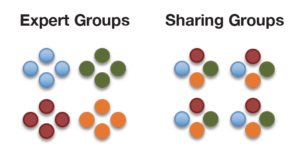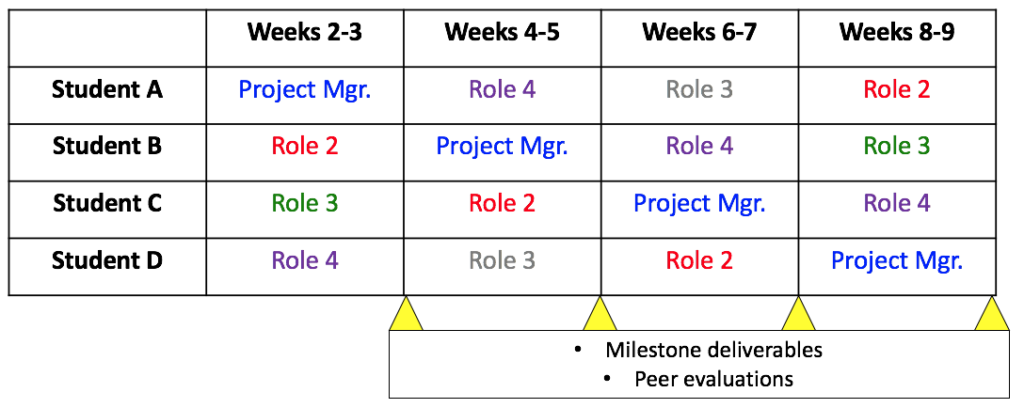This post is part of a series on Active Learning methods. Click here to see the menu for this series.
Students groups are frequently used to increase engagement and activate learning. Importantly, groups must have clear goals and structures, or else participants are likely to drift off-task. These are just a few examples of the many forms that student groups can take.
Some Techniques
Jigsaw
The “jigsaw” approach (e.g., Colosi & Zales, 1998) is designed to facilitate both expertise and integration.
Students belong to two groups: an expert group and a sharing group, and meet with their two groups sequentially. Expert groups are each assigned different collections of material to learn or prepare outside of class. In class, expert groups first convene to calibrate, then they adjourn into sharing groups comprised of one member from each expert group. Every expert must share what they know in order for the group to make a decision or complete a task. This activity enables students to fluidly move between the roles of expert and learner.
Debates
In debates, students are assigned topics and sides to research and debate in front of the class. For additional critical thinking, the Constructive Controversy approach (Johnson, Johnson & Smith, 2000) requires students to switch sides and argue counter to their original position, after which both sides come together and discuss the anatomy of the issue at hand, regardless of one’s position. Debates are an excellent way to promote perspective-taking in students in which they have to prepare arguments in a way that takes into consideration potential rebuttals from their opponents.
Team-Based Learning
In Team-Based Learning (e.g., Sweet & Michaelsen, 2012), students are strategically organized into permanent teams, and each unit begins with a two-stage collaborative exam over preparation materials, requiring that they come to consensus on team answers, on which they get immediate performance feedback. This sequence quickly builds trust and cohesiveness within the team, motivating students to prepare well outside of class, as they know they will be accountable to their team mates. Subsequent lecture is explanatory rather than didactic, and most class time is spent on carefully-designed application activities that apply material students acquired outside of class. Students occasionally give each other peer-evaluation feedback on one-another’s preparation and contribution to team efforts. Overall, this method creates a situation in which students’ social and intellectual experience of the course are interlocked and amplified. See our Team-Based Learning post for more details.
Group Projects
While a common approach to group learning, projects in which students must work together as groups to produce a complex product have a checkered history. Sometimes the groups find their way to success, while other times groups struggle either with the task or social dimensions of group work. The entire profession of project management exists because working together to produce a complex product is difficult, and if we are going to ask this of our students, we should provide as much structure and feedback as possible. This should include:
- Sequenced activities, with
- Milestone deliverables for which they receive feedback
- Peer evaluations of contributions along the way,
- If possible, a rotating role “Project Manager” to keep the group on task and productive.
Example of a Well-Structured Group Project
Some Technology to Support Active Learning Groups
Though definitely not necessary, a few technology platforms have been developed to specifically support various forms of group learning. Though definitely not necessary for active learning, judicious use of specific technology platforms can bring an extra dimension of organization and engagement to the experience. Academic Technology Services provides hands-on training and individualized consultations on many forms of instructional technology.
Group Learning Facilitation Systems
Far beyond “clickers,” a few systems exist to robustly support structured active learning groups.  Platforms like Learning Catalytics can pinpoint student misconceptions in real time and facilitate both the individual and team phases of team-based learning with many different question templates.
Platforms like Learning Catalytics can pinpoint student misconceptions in real time and facilitate both the individual and team phases of team-based learning with many different question templates.
Student Peer-Evaluation Platforms
Online systems like TEAMMATES make student peer-evaluation fast and efficient, enabling students to  learn about their own performance from each other in ways they may never be able to learn from the instructor.
learn about their own performance from each other in ways they may never be able to learn from the instructor.
References
